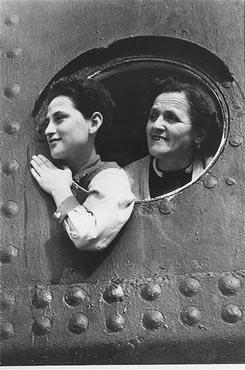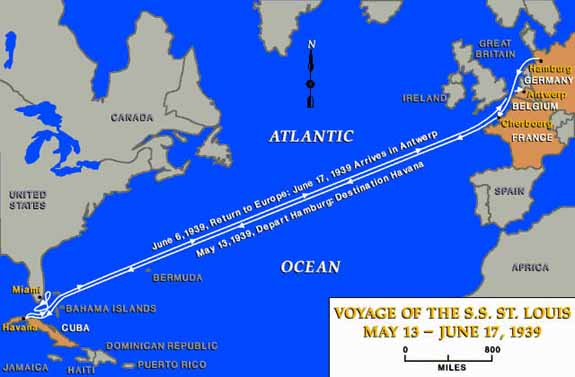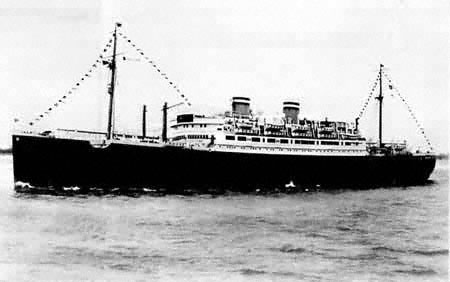
Hannelore Grünberg-Klein was a young girl when she fled Germany with her father and mother in the spring/summer of 1939. They managed to get a place on the St Louis, a passengersship of the Hapag compagny, that was sailing with a thousand Jews to Cuba. In Cuba the refugees were denied entry.
After weeks on sea and idle attempts to enter the United States, she came with seventy other refugees to the Lloyd Hotel. She lived in the Lloyd for several months. Two months after the war began in The Netherlands she and her family were transferred to Camp Westerbork.
“My parents waited too long. It was the very last moment that Jews could leave Germany legally. There was no country that accepted Jews. Cuba did, but my parents knew that the country was very corrupt, governments succeeded eachother very fast.
Our visa were not admitted. The captain of the ship knew that if we would return to Germany we inmediatly would be put in a concentrationcamp. With a delegation of the passengers he negotiated other destinations.
The United States did not want to have us. After a week of negotiations it became clear that we had to split up and we could go to the United Kingdom, France, Belgium and The Netherlands. My father had a sister in Holland who, with her family, could hardly sustain because of the financial crisis.

On June 18 we arrived at the Quarantainebuilding on Heyplaat in the Rotterdam harbour. We – as legal asylumseekers were put behind lock and key in barracks. With the invitation of Queen Wilhelmina and an orange welcome-flower pinned on our lapel!!
We did not know that we would not be free for the next six years and that most of us would never be free. A part of our group, among them my parents and myself, came to the Lloyd Hotel in the 2nd half of July 1939. The rest went to the Zeeburgerdijk in Amsterdam.
We entered the Lloyd via the entrance on the left side of the building, opposite the decontamination-building. On the left there was a small shop and a caretaker. We were brought to our room. We, the people of the St. Louis, were put in a hall at the end of a long corridor, on the second floor on the westside. The hall was compartimented in small rooms. Ours was at the end on the leftside.

They were about eight square meters. There was a bed on every wall. There was almost no room left. You could hear everything from your neighbours. Next to the hall you could wash yourself at a tap and there were toilets. We had no showers.
Our coming to the Lloyd Hotel was the start of a difficult period for us. My mother helped in the kitchen. She got an accident in the very first days as she got her hand in a bread-slicer.
A doctor and a nurse, also refugees, gave first aid at their office on the second floor. Her hand healed, but she suffered a tremendous shock. She became as apathic as years later, when dad was transported to Auschwitz.
Shortly after that I had an accident too. I wanted to open one of the sash windows. It must have been one of the stained windows in the stairwell. I had never seen windows like that in Germany. You could see all the way to the Zuiderzee, over the water with freight- en passengersships who sailed by.
I always wanted to have fresh air. As little as I was I thought – I must open that window, but I did not know how. The whole window fell on top of my hand. I was helped in the doctors-chamber and had to walk with a wet bandage. After weeks it healed. But most of my memories of the time in the Lloyd are not tragic and that is the case for most of the children I know in the Lloyd hotel: Max en Alex Gruber, Martin en Judith Mendel, Suzy Levenbach, Bety Kubashka en Renate Weltmann. My friend Alex Gruber and I could play for hours in the empty trains in the yard behind the Lloyd. It did not give us a bad impression at all. Children were kept away from the problems to protect them.
added feb 2015
Hannelore and her family arrivered on July 1rst, 1940 In Westerbork. They stayed there as “Alte Insassen” until their deportation on January 18th, 1944 to Theresienstadt. In Westerbork Hannelore went to school and became a member of the Schülerkreis.
From Theresienstadt they were deported to Auschwitz. Hannelore survived Auschwitz en went, as many prisoners, to different camps as the Russian army came in the vicinity of Auschwitz. Hannelore was liberated near Mauthausen, her parents did not survive Auschwitz. After the war Hannelore married and became the mother of two children, a daughter and a son.
Source:
Lubbers, Annette, Lloydhotel; Uitgeverij Bas Lubberhuizen, (Amsterdam 2004).
addendum 11 feb 2015: Moraal, Eva, Als ik morgen op transport ga (daarin Grünberg-Klein, H, “Zolang er nog tranen zijn” 1990)
www.joodsmonument.nl, lemma gezin Leopold Klein (reviewd 12 feb 2015).
with thanks to Annette Lubbers
Last change:
September 14, 2019
